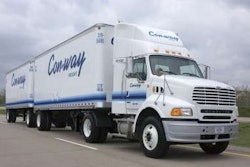Trucking is at the heart of our nation’s economy and is key to our economic turnaround, Dan Ustian – chairman, president and chief executive officer of Navistar International Corp. – told attendees at the annual Heavy Duty Manufacturers Association Breakfast & Briefing.
While headlines focus on what’s wrong with the economy – the housing market, credit crisis, unemployment, consumer spending – “What’s missing is truckers,” Ustian said at the breakfast event, held Friday, March 20, during the Mid-America Trucking Show in Louisville, Ky. “Who knows better the state of the economy?”
Pointing to the federal government’s bailout of some automakers and suppliers, Ustian said: “We’d like them to stand on their own two feet, but we need them to be successful.” From the suppliers’ perspective, “if one of those goes belly-up, we’re going to have trouble, and it will affect the trucking industry.” Ustian showed a chart indicating that since 2006, auto sales are down about 25 percent and truck sales are down 50 percent. “Trucks are way more volatile,” he said. “The only guys buying today are the bigger guys” who “have all the leverage in terms of pricing.”
Efforts to meet changing emissions regulations will have an ongoing effect on truck sales, Ustian said. While noting that everyone in the room favored environmental initiatives, “we should be part of that clean air decision,” he said. He cited the need for greater effort toward getting older trucks off the road by encouraging truckers to buy new, but acknowledged that since 2004, emissions technology has increased the sticker price of trucks by $25,000. And if the Obama administration allows each state to make its own emissions rules – as the president has suggested – that could pose serious long-term problems for truckmakers, he said.
The industry has dealt with these challenges through consolidation and by leveraging assets through vertical integration, Ustian said. He noted competitors’ strategy to import products. “We’ve done it a different way,” he said, citing Navistar’s programs to repurpose existing chassis, such as for its military vehicles.
To meet the U.S. Environmental Protection Agency’s 2010 emissions regulations, Navistar has chosen “a different direction” by using enhanced exhaust gas recirculation versus the selective catalytic reduction technology embraced by the other engine makers. “It’s the same principle of leveraging assets,” Ustian said. “You don’t need to spend as much money.”
Another way manufacturers can reduce costs is by sourcing parts globally, Ustian said. “If you’re not doing it, you’d better because you have to survive.” Navistar has realized 15 percent to 20 percent cost reductions through global sourcing, “and the quality is good,” he said.
Fixing the economic problems our country faces will require more voices to be heard, Ustian said. Some of the efforts being discussed by Congress and the administration – card check and higher taxes on businesses, for example – are under consideration because the constituencies that embrace them have been the loudest. To change that course, we must educate our government leaders, he said. “We’re seeing signs [of improvement] already,” he said. “And when the government understands the impact of some of what they are doing, it will move even faster.”














